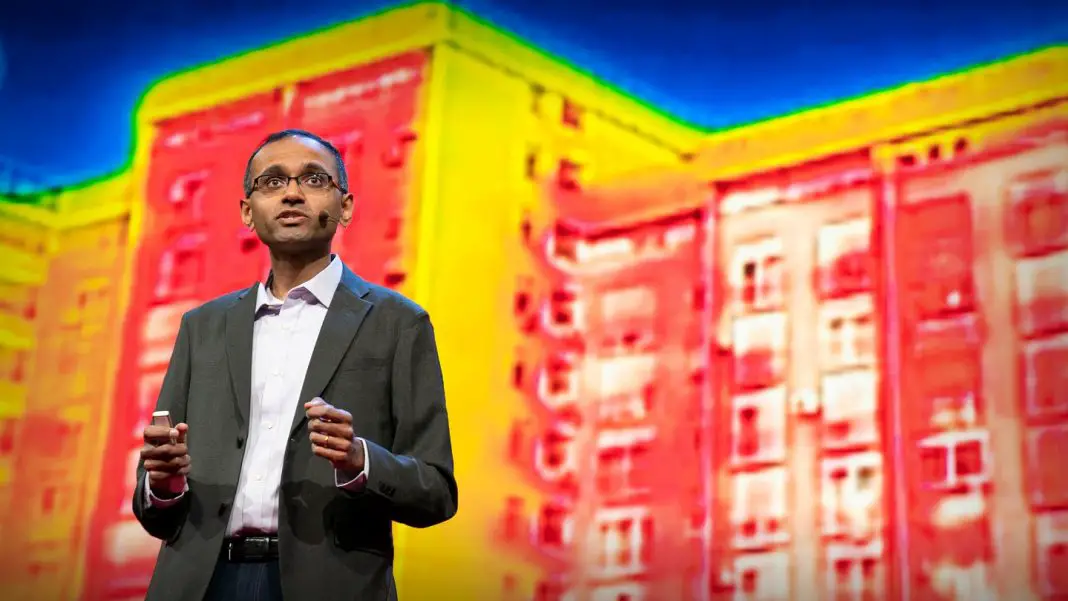How we can turn the cold of outer space into a renewable resource
Every summer when I was growing up, I would fly from my home in Canada to visit my grandparents, who lived in Mumbai, India. Now, Canadian summers are pretty mild at best –about 22 degrees Celsius or 72 degrees Fahrenheit is a typical summer’s day, and not too hot. Mumbai, on the other hand, is a hot and humid place well into the 30s Celsius or 90s Fahrenheit. As soon as I’d reach it, I’d ask, “How could anyone live, work or sleep in such weather?” To make things worse, my grandparents didn’t have an air conditioner. And while I tried my very, very best, I was never able to persuade them to get one. But this is changing, and fast.
====================================
English Tips: 5 Tips for self-study speaking English Naturally
====================================
Humid:
00:59
Cooling systems today collectively account for 17 percent of the electricity we use worldwide. This includes everything from the air conditioners I so desperately wanted during my summer vacations, to the refrigeration systems that keep our food safe and cold for us in our supermarkets, to the industrial scale systems that keep our data centers operational. Collectively, these systems account for eight percent of global greenhouse gas emissions.
- Account for sth: to form, use, or produce a particular amount or part of a group of people or things
- Desperate (adj) /ˈdes.pər.ət/: very serious or bad
- Emissions(n) /iˈmɪʃ.ən/: the act of sending out gas, heat, light
01:27
But what keeps me up at night is that our energy use for cooling might grow six fold by the year 2050, primarily driven by increasing usage in Asian and African countries. I’ve seen this firsthand. Nearly every apartment in and around my grandmother’s place now has an air conditioner.
- Fold(suffix)/ -fəʊld/: having the statednumber of parts, or multiplied by the stated number
- Primarily (adv) /praɪˈmer.əl.i/: mainly
- Firsthand adv): If you experience something firsthand, you experience it yourself
And that is, emphatically, a good thing for the health, well-being and productivity of people living in warmer climates. However, one of the most alarming things about climate change is that the warmer our planet gets, the more we’re going to need cooling systems — systems that are themselves large emitters of greenhouse gas emissions.
- Emphatic (adj) /emˈfæt.ɪk/: done or said in a strong way and without any doubt
example: The minister has issued an emphatic rejection of the accusation.
This then has the potential to cause a feedback loop, where cooling systems alone could become one of our biggest sources of greenhouse gases later this century. In the worst case, we might need more than 10 trillion kilowatt-hours of electricity every year, just for cooling, by the year 2100. That’s half our electricity supply today. Just for cooling. But this also point us to an amazing opportunity. A 10 or 20 percent improvement in the efficiency of every cooling system could actually have an enormous impact on our greenhouse gas emissions, both today and later this century. And it could help us avert that worst-case feedback loop.
- Avert(v) /əˈvɜːt/: to prevent something bad from happening
02:54
I’m a scientist who thinks a lot about light and heat. In particular, how new materials allow us to alter the flow of these basic elements of nature in ways we might have once thought impossible. So, while I always understood the value of cooling during my summer vacations, I actually wound up working on this problem because of an intellectual puzzle that I came across about six years ago. How were ancient peoples able to make ice in desert climates? This is a picture of an ice house, also called a Yakhchal, located in the southwest of Iran. There are ruins of dozens of such structures throughout Iran, with evidence of similar such buildings throughout the rest of the Middle East and all the way to China.
- Alter(v): /ˈɒl.tər/: to change something, usually slightly
- Wound up(adj)/ˌwuːnd ˈʌp/: very worried, nervous
- Puzzle (n) /ˈpʌz.əl/ : a situation that is difficult to understand
- Puzzle (v): to cause someone to feel confused and slightly worried
- Ruin /ˈruː.ɪn/ (n): the broken parts that are left from an old building or town
- Ruin(v): to spoil or destroy something completely
03:42
The people who operated this ice house many centuries ago, would pour water in the pool you see on the left in the early evening hours, as the sun set. And then something amazing happened. Even though the air temperature might be above freezing, say five degrees Celsius or 41 degrees Fahrenheit, the water would freeze.
- Pour(v) /pɔːr/: to make a substance flow from a container
The ice generated would then be collected in the early morning hours and stored for use in the building you see on the right, all the way through the summer months. You’ve actually likely seen something very similar at play if you’ve ever noticed frost form on the ground on a clear night, even when the air temperature is well above freezing. But wait. How did the water freeze if the air temperature is above freezing? Evaporation could have played an effect, but that’s not enough to actually cause the water to become ice. Something else must have cooled it down.
- Frost(n) /frɒst/: a weathercondition in which the air temperature falls below the freezing point of water, especially outside at night
- Evaporation(n) /ɪˌvæp·əˈreɪ·ʃən/: the process of changing from a liquid to a gas, or a change from a liquid to a gas
04:34
Think about a pie cooling on a windowsill. For it to be able to cool down, its heat needs to flow somewhere cooler. Namely, the air that surrounds it. As implausible as it may sound, for that pool of water, its heat is actually flowing to the cold of space.
- Implausible (adj) /ɪmˈplɔː.zə.bəl/: difficult to believe, or unlikely
- Windowsill(n): a shelf below a window, either inside or outside a building
04:54
How is this possible? Well, that pool of water, like most natural materials, sends out its heat as light. This is a concept known as thermal radiation. In fact, we’re all sending out our heat as infrared light right now, to each other and our surroundings. We can actually visualize this with thermal camera sand the images they produce, like the ones I’m showing you right now. So that pool of water is sending out its heat upward towards the atmosphere. The atmosphere and the molecules in it absorb some of that heat and send it back. That’s actually the greenhouse effect that’s responsible for climate change.
- Sends out (phrasal verb): to allowa substance such as smoke or chemicals to escape into the atmosphere
- Thermal (n, adj) /ˈθɜː.məl/: connectedwith heat
- Radiation (n) /ˌreɪ.diˈeɪ.ʃən/: a form of energy that comes from a nuclear reaction and that can be very dangerous to health:
- Molecules (n) /ˈmɒl.ɪ.kjuːl/: the simplestunit of a chemical substance
05:32
But here’s the critical thing to understand. Our atmosphere doesn’t absorb all of that heat. If it did, we’d be on a much warmer planet. At certain wavelengths, in particular between eight and 13 microns, our atmosphere has what’s known as a transmission window. This window allows some of the heat that goes up as infrared light to effectively escape, carrying away that pool’s heat. And it can escape to a place that is much, much colder.
- Critical (adj): /ˈkrɪt.ɪ.kəl/ expressingan opinion when you think something is wrong or bad
- Critical (adj): very important
- Wavelength (n)/weɪv.leŋθ/: the distance between two waves of energy
The cold of this upper atmosphere and all the way out to outer space, which can be as cold as minus 270 degrees Celsius, or minus 454 degrees Fahrenheit. So that pool of water is able to send out more heat to the sky than the sky sends back to it. And because of that, the pool will cool down below its surroundings’ temperature. This is an effect known as night-sky cooling or radiative cooling. And it’s always been understood by climate scientists and meteorologists as a very important natural phenomenon.
- meteorologists (n) /ˌmiː.ti.əˈrɒl.ə.dʒɪst/: someone who studies meteorology
- Come across(phrasal verb): to meet someone, or to find something by chance
06:40
When I came across all of this, it was towards the end of my PhD at Stanford. And I was amazed by its apparent simplicity as a cooling method, yet really puzzled. Why aren’t we making use of this? Now, scientists and engineers had investigated this idea in previous decades. But there turned out to be at least one big problem. It was called night-sky cooling for a reason. Why? Well, it’s a little thing called the sun. So, for the surface that’s doing the cooling, it needs to be able to face the sky. And during the middle of the day, when we might want something cold the most, unfortunately, that means you’re going to look up to the sun. And the sun heats most materials up enough to completely counteract this cooling effect.
- Counteract(v) ˌkaʊn.tərˈækt/: to reduce or remove the effect of something unwanted by producing an opposite effect
07:28
My colleagues and I spend a lot of our time thinking about how we can structure materials at very small length scales such that they can do new and useful things with light — length scales smaller than the wavelength of light itself. Using insights from this field, known as nano photonics or meta materials research, we realized that there might be a way to make this possible during the day for the first time.
Meta material(n): A meta material is a material engineered to have a property that is not found in nature
07:49
To do this, I designed a multilayer optical material shown here in a microscope image. It’s more than 40 times thinner than a typical human hair. And it’s able to do two things simultaneously. First, it sends its heat out precisely where our atmosphere lets that heat out the best. We targeted the window to space. The second thing it does is it avoids getting heated up by the sun. It’s a very good mirror to sunlight. The first time I tested this was on a rooftop in Stanford that I’m showing you right here. I left the device out for a little while, and I walked up to it after a few minutes, and within seconds, I knew it was working. How? I touched it, and it felt cold.
Microscope (n): /ˈmaɪ.krə.skəʊp/: a device that uses lenses to make very small objects look larger
08:33
(Applause)
08:38
Just to emphasize how weird and counterintuitive this is: this material and others like it will get colder when we take them out of the shade, even though the sun is shining on it. I’m showing you data here from our very first experiment, where that material stayed more than five degrees Celsius, or nine degrees Fahrenheit, colder than the air temperature, even though the sun was shining directly on it.The manufacturing method we used to actually make this material already exists at large volume scales. So I was really excited, because not only do we make something cool, but we might actually have the opportunity to do something real and make it useful. That brings me to the next big question.
09:21
How do you actually save energy with this idea? Well, we believe the most direct way to save energy with this technology is as an efficiency boost for today’s air-conditioning and refrigeration systems. To do this, we’ve built fluid cooling panels, like the ones shown right here. These panels have a similar shape to solar water heaters, except they do the opposite — they cool the water, passively, using our specialized material. These panels can then be integrated with a component almost every cooling system has, called a condenser, to improve the system’s underlying efficiency. Our start-up, SkyCool Systems, has recently completed a field trial in Davis, California, shown right here. In that demonstration, we showed that we could actually improve the efficiency of that cooling system as much as 12 percent in the field.
10:07
Over the next year or two, I’m super excited to see this go to its first commercial-scale pilots in both the air conditioning and refrigeration space. In the future, we might be able to integrate these kinds of panels with higher efficiency building cooling systems to reduce their energy usage by two-thirds.And eventually, we might actually be able to build a cooling system that requires no electricity input at all. As a first step towards that, my colleagues at Stanford and I have shown that you could actually maintain something more than 42 degrees Celsius below the air temperature with better engineering.
10:45
Thank you.
10:46
(Applause)
10:51
So just imagine that — something that is below freezing on a hot summer’s day. So, while I’m very excited about all we can do for cooling, and I think there’s a lot yet to be done, as a scientist, I’m also drawn to a more profound opportunity that I believe this work highlights. We can use the cold darkness of space to improve the efficiency of every energy-related process here on earth. One such process I’d like to highlight are solar cells. They heat up under the sun and become less efficient the hotter they are. In 2015, we showed that with deliberate kinds of microstructures on top of a solar cell, we could take better advantage of this cooling effect to maintain a solar cell passively at a lower temperature. This allows the cell to operate more efficiently. We’re probing these kinds of opportunities further. We’re asking whether we can use the cold of space to help us with water conservation. Or perhaps with off-grid scenarios. Perhaps we could even directly generate power with this cold. There’s a large temperature difference between us here on earth and the cold of space. That difference, at least conceptually, could be used to drive something called a heat engine to generate electricity. Could we then make a nighttime power-generation device that generates useful amounts of electricity when solar cells don’t work? Could we generate light from darkness?
12:23
Central to this ability is being able to manage the thermal radiation that’s all around us. We’re constantly bathed in infrared light; if we could bend it to our will, we could profoundly change the flows of heat and energy that permeate around us every single day. This ability, coupled with the cold darkness of space, points us to a future where we, as a civilization, might be able to more intelligently manage our thermal energy footprint at the very largest scales.
12:57
As we confront climate change, I believe having this ability in our toolkit will prove to be essential. So, the next time you’re walking around outside, yes, do marvel at how the sun is essential to life on earth itself, but don’t forget that the rest of the sky has something to offer us as well.
13:20
Thank you.





